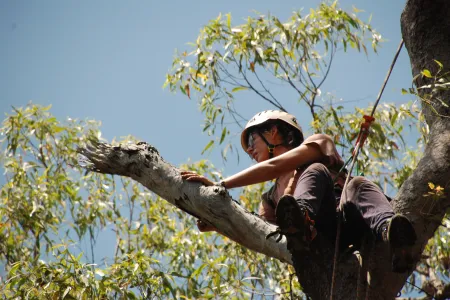NEWS ARTICLE
Tree hollows count for endangered species
In a bid to save hollow-dependent endangered species, Charles Darwin University PhD candidate Cara Penton has scaled more than 180 trees on the Tiwi Islands in the Northern Territory.
The research, which affects several of Australia’s most vulnerable species, suggests that the number of tree hollows in Northern Australia has been over-estimated by up to 30%.
Ms Penton said the most common approach to assessing the abundance of tree hollows was a ground-based count.
“But our work shows that this method results in big over-estimates and there are many fewer hollows in the savannas than originally thought.”
By climbing trees rather than using binoculars to scan canopies from the ground, Ms Penton has discovered that many tree hollows were blocked solid by termites.
The discrepancy between “total hollows” and “available hollows” has important implications for the conservation of many threatened and declining species, including the black-footed tree-rat (Mesembriomys gouldii) and brush-tailed rabbit-rat (Conilurus penicillatus).
“As soon as you take away all the tree hollows that are blocked, which is almost 30%, then we have a more realistic estimate,” she said.
Ms Penton suggested that land managers should include both ground-based and climbing counts on a subsample of trees to account for survey error due to blocked hollows. Alternatively, small drones could be used to confirm hollow availability.
“Land managers should look for big hollows and evidence of termite gut rather than just counting all the hollows,” she said.
“Smaller hollows are more likely to be blocked, so count with caution.
“Whether we are looking at fire management or land clearing and development, it’s important to consider quality habitat.”
She said she believed that a clearer understanding of available hollows was important for identifying and managing areas of high conservation value.
“Focusing on depth of hollows will make sure ground-counts are better than they have been in the past,” she said.
The research paper, entitled “Blocked-off: termitaria cause the overestimation of tree hollow availability by ground-based surveys in northern Australia”, has been published in the journal Forest Ecology and Management.
Related Articles

Conservation planning ‘good for biodiversity and business’
The Northern Territory’s investment in solar and wind energy production needs to benefit people and the planet, but new research highlights critical pitfalls in planning.
Read more about Conservation planning ‘good for biodiversity and business’
Cotton trash to treasure: Project using waste to grow new mushroom industry
Supermarket shelves could be stocked with mushrooms grown from the Northern Territory’s cotton waste, with a Charles Darwin University research project exploring the possibility of broadening the region’s agricultural industry.
Read more about Cotton trash to treasure: Project using waste to grow new mushroom industry
Stereotypes holding back Australia’s recreational fishing future, new study finds
Outdated stereotypes about who a “real fisher” is could be costing Australia’s recreational fishing industry valuable talent, creativity, and growth, new research from Charles Darwin University suggests.
Read more about Stereotypes holding back Australia’s recreational fishing future, new study finds
